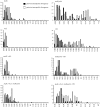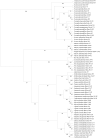ITS and trnH-psbA as Efficient DNA Barcodes to Identify Threatened Commercial Woody Angiosperms from Southern Brazilian Atlantic Rainforests
- PMID: 26630282
- PMCID: PMC4704546
- DOI: 10.1371/journal.pone.0143049
ITS and trnH-psbA as Efficient DNA Barcodes to Identify Threatened Commercial Woody Angiosperms from Southern Brazilian Atlantic Rainforests
Abstract
The Araucaria Forests in southern Brazil are part of the Atlantic Rainforest, a key hotspot for global biodiversity. This habitat has experienced extensive losses of vegetation cover due to commercial logging and the intense use of wood resources for construction and furniture manufacturing. The absence of precise taxonomic tools for identifying Araucaria Forest tree species motivated us to test the ability of DNA barcoding to distinguish species exploited for wood resources and its suitability for use as an alternative testing technique for the inspection of illegal timber shipments. We tested three cpDNA regions (matK, trnH-psbA, and rbcL) and nrITS according to criteria determined by The Consortium for the Barcode of Life (CBOL). The efficiency of each marker and selected marker combinations were evaluated for 30 commercially valuable woody species in multiple populations, with a special focus on Lauraceae species. Inter- and intraspecific distances, species discrimination rates, and ability to recover species-specific clusters were evaluated. Among the regions and different combinations, ITS was the most efficient for identifying species based on the 'best close match' test; similarly, the trnH-psbA + ITS combination also demonstrated satisfactory results. When combining trnH-psbA + ITS, Maximum Likelihood analysis demonstrated a more resolved topology for internal branches, with 91% of species-specific clusters. DNA barcoding was found to be a practical and rapid method for identifying major threatened woody angiosperms from Araucaria Forests such as Lauraceae species, presenting a high confidence for recognizing members of Ocotea. These molecular tools can assist in screening those botanical families that are most targeted by the timber industry in southern Brazil and detecting certain species protected by Brazilian legislation and could be a useful tool for monitoring wood exploitation.
Conflict of interest statement
Figures



References
-
- Stehmann JR, Forzza RC, Salino A, Sobral M, Costa DP, Kamino LHY. Plantas da Floresta Atlântica. 1st ed Rio de Janeiro: Jardim Botânico do Rio de Janeiro; 2009.
-
- Veloso HP, Rangel-Filho ALR, Lima ICA. Classificação da vegetação brasileira, adaptada a um sistema universal. 1st ed Rio de Janeiro: IBGE; 1991.
-
- Koch Z, Corrêa MC. Araucária: a floresta do Brasil Meridional. 1st ed Curitiba: Olhar Brasileiro; 2002.
-
- Reitz R, Klein RM, Reis A. Madeiras do Brasil. 1st ed Florianópolis: Lunardelli; 1979.
-
- Isernhagen I, Silva SM, Rodrigues W, Galvão F. Listagem de espécies arbustivo-arbóreas citadas nos trabalhos de fitossociologia florestal no Paraná, Brasil: uma contribuição aos programas de recuperação de áreas degradadas (RAD). In: Isernhagen I. A fitossociologia florestal no Paraná e os programas de recuperação de áreas degradadas: uma avaliação. Piracicaba: Instituto de Pesquisa e Estudo Florestais. M.Sc. Thesis. Universidade Federal do Paraná. 2001. pp. 511–134. Available: http://www.ipef.br/servicos/teses/arquivos/isernhagen,i.pdf
Publication types
MeSH terms
Substances
Associated data
- Actions
- Actions
- Actions
- Actions
- Actions
- Actions
- Actions
- Actions
- Actions
- Actions
- Actions
- Actions
- Actions
- Actions
- Actions
- Actions
- Actions
- Actions
- Actions
- Actions
- Actions
- Actions
- Actions
- Actions
- Actions
- Actions
- Actions
- Actions
- Actions
- Actions
- Actions
- Actions
- Actions
- Actions
- Actions
- Actions
- Actions
- Actions
- Actions
- Actions
- Actions
- Actions
- Actions
- Actions
- Actions
- Actions
- Actions
- Actions
- Actions
- Actions
- Actions
- Actions
- Actions
- Actions
- Actions
- Actions
- Actions
- Actions
- Actions
- Actions
- Actions
- Actions
- Actions
- Actions
- Actions
- Actions
- Actions
- Actions
- Actions
- Actions
- Actions
- Actions
- Actions
- Actions
- Actions
- Actions
- Actions
- Actions
- Actions
- Actions
- Actions
- Actions
- Actions
- Actions
- Actions
- Actions
- Actions
- Actions
- Actions
- Actions
- Actions
- Actions
- Actions
- Actions
- Actions
- Actions
- Actions
- Actions
- Actions
- Actions
- Actions
- Actions
- Actions
- Actions
- Actions
- Actions
- Actions
- Actions
- Actions
- Actions
- Actions
- Actions
- Actions
- Actions
- Actions
- Actions
- Actions
- Actions
- Actions
- Actions
- Actions
- Actions
- Actions
- Actions
- Actions
- Actions
- Actions
- Actions
- Actions
- Actions
- Actions
- Actions
- Actions
- Actions
- Actions
- Actions
- Actions
- Actions
- Actions
- Actions
- Actions
- Actions
- Actions
- Actions
- Actions
- Actions
- Actions
- Actions
- Actions
- Actions
- Actions
- Actions
- Actions
- Actions
- Actions
- Actions
- Actions
- Actions
- Actions
- Actions
- Actions
- Actions
- Actions
- Actions
- Actions
- Actions
- Actions
- Actions
- Actions
- Actions
- Actions
- Actions
- Actions
- Actions
- Actions
- Actions
- Actions
- Actions
- Actions
- Actions
- Actions
- Actions
- Actions
- Actions
- Actions
- Actions
- Actions
- Actions
- Actions
- Actions
- Actions
- Actions
- Actions
- Actions
- Actions
- Actions
- Actions
- Actions
- Actions
- Actions
- Actions
- Actions
- Actions
- Actions
- Actions
- Actions
- Actions
- Actions
- Actions
- Actions
- Actions
- Actions
- Actions
- Actions
- Actions
- Actions
- Actions
- Actions
- Actions
- Actions
- Actions
- Actions
- Actions
- Actions
- Actions
- Actions
- Actions
- Actions
- Actions
- Actions
- Actions
- Actions
- Actions
- Actions
- Actions
- Actions
- Actions
- Actions
- Actions
- Actions
- Actions
- Actions
- Actions
- Actions
- Actions
- Actions
- Actions
- Actions
- Actions
- Actions
- Actions
- Actions
- Actions
- Actions
- Actions
- Actions
- Actions
- Actions
- Actions
- Actions
- Actions
- Actions
- Actions
- Actions
- Actions
- Actions
- Actions
- Actions
- Actions
- Actions
- Actions
- Actions
- Actions
- Actions
- Actions
- Actions
- Actions
- Actions
- Actions
- Actions
- Actions
- Actions
- Actions
- Actions
- Actions
- Actions
- Actions
- Actions
- Actions
- Actions
- Actions
- Actions
- Actions
- Actions
- Actions
- Actions
- Actions
- Actions
- Actions
- Actions
- Actions
- Actions
- Actions
- Actions
- Actions
- Actions
- Actions
- Actions
- Actions
- Actions
- Actions
LinkOut - more resources
Full Text Sources
Other Literature Sources
Miscellaneous

